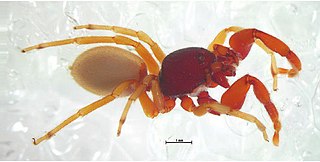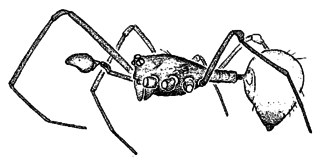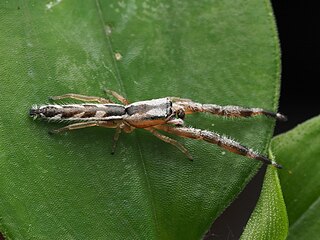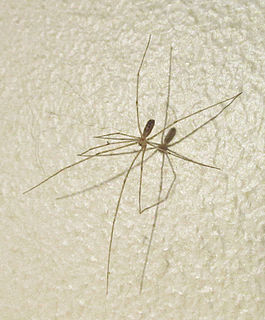
The family Dipluridae, known as curtain-web spiders are a group of spiders in the infraorder Mygalomorphae, that have two pairs of booklungs, and chelicerae (fangs) that move up and down in a stabbing motion. A number of genera, including that of the Sydney funnel-web spider (Atrax), used to be classified in this family but have now been moved to Hexathelidae.

The wafer trapdoor spiders, family Cyrtaucheniidae, are a widespread family of spiders that lack the thorn-like spines on tarsi and metatarsi I and II found in true trapdoor spiders (Ctenizidae).

Parasteatoda tepidariorum, the common house spider, referred to internationally as the American house spider, is a spider species of the genus Parasteatoda that is mainly indigenous to the New World, with P. tepidariorum australis but has achieved a cosmopolitan distribution. American house spiders are synanthropic and build their tangled webs in or near human dwellings, greenhouses or similar, often in secluded areas such as between loose walls and behind open doors and attic windows. Statistically, they are the most often encountered spider by humans in North America, and least likely to adopt defensive behavior in their vicinity. Their prey mechanism is similar to that of the other cobweb spiders: the spider follows disturbances transmitted along the web to entangle and then paralyze its prey, which usually consists of household insects and other invertebrates.

Crevice weaver spiders (Filistatidae) comprise cribellate spiders with features that have been regarded as "primitive" for araneomorph spiders. They are weavers of funnel or tube webs. The family contains 18 genera and more than 120 described species worldwide.

Steatoda grossa, commonly known as the cupboard spider, the dark comb-footed spider, the brown house spider, or the false widow, is a common species of spider in the genus Steatoda.

The black house spider or common black spider is a common species of cribellate Australian spider, introduced to New Zealand and Japan. A closely related species, Badumna longinqua, the grey house spider, has a similar distribution, but has also been introduced to the Americas.

Attulus pubescens is a species of jumping spiders. Until 2017, it was known as Sitticus pubescens.

Periegops is a genus of spiders with six eyes instead of the usual eight. It is the only genus in its family (Periegopidae) and has three described species. It was long considered to be members of Sicariidae or Segestriidae until Raymond Forster elevated them to the family level in 1995.

The Palpimanoidea or palpimanoids, also known as assassin spiders, are a group of araneomorph spiders, originally treated as a superfamily. As with many such groups, its circumscription has varied. As of September 2018, the following five families were included:

Cerocida is a spider genus known only from tropical South America.
Leucauge celebesiana, commonly called the black-striped orchard spider, is a species of spider belonging to the family Tetragnathidae. It is found from India to China, Japan, Sulawesi and New Guinea.

Titanoeca quadriguttata is a species of spider in the family Titanoecidae. It is widespread in Europe, though absent from Great Britain, and is found in Austria, Belgium, Bulgaria, Corsica, Croatia, Czech Republic, France, Germany, Greece, Hungary, Italy, Liechtenstein, Moldova, Russia, Slovakia, Spain, Switzerland, the Netherlands, Ukraine.

Marpissa pikei is a species of jumping spider that is found in the eastern United States, Texas, New Mexico, Arizona and Cuba.

Sphodros niger, the black purse-web spider, is a mygalomorph spider from the Eastern United States. It is listed as a special concern species in Connecticut.

Psilochorus is a genus of spiders in the family Pholcidae.

Zygoballus sexpunctatus is a species of jumping spider which occurs in the southeastern United States where it can be found in a variety of grassy habitats. Adult spiders measure between 3 and 4.5 mm in length. The cephalothorax and abdomen are bronze to black in color, with reddish brown or yellowish legs. The male has distinctive enlarged chelicerae and front femora. Like many jumping spiders, Z. sexpunctatus males exhibit ritualized courtship and agonistic behavior.
Psilochorus apicalis is a species of cellar spider in the family Pholcidae. It is found in the USA.

Psilochorus simoni is a species of cellar spider in the family Pholcidae. It is found in the United States, has been introduced into Europe, Turkey, and New Zealand.
Psilochorus utahensis is a species of cellar spider in the family Pholcidae. It is found in the United States.
Psilochorus californiae is a species of cellar spider in the family Pholcidae. It is found in the United States and Mexico.















